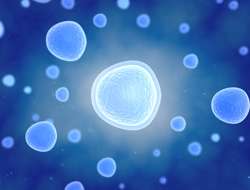Testing a 40-year old cell membrane theory

European researchers conducted state-of-the-art high-resolution imaging experiments of protein diffusion in artificial cell membranes. Results provided the first experimental evidence of an important theory regarding membrane dynamics that had remained untested for nearly 40 years due to its technically difficult nature.
Most mammalian cells are like tiny water balloons. They have a phospholipid (PL) cell membrane in which numerous proteins and other molecules are embedded that separates the internal from the external milieu.
The ‘fluid mosaic’ model describes the PL membrane, with ‘mosaic’ referring to the variety of molecules making up the membrane and ‘fluid’ indicating the ability of these molecules to move around laterally within the membrane as if it were fluid rather than solid.
Neurons, or cells that send and receive signals in the nervous system, have a PL membrane. However, they also have numerous morphological peculiarities and, as is most often the case, structure that can be related to function.
Most neurons consist of a cell body, one long axon extending in one direction, and many odd tree-like extensions called dendrites in the other direction. The axons transmit information and the dendrites receive it from other cells.
Dendrites are further specialised, exhibiting numerous little mushroom-like extensions called dendritic spines with bulbous heads and thin necks, the true signal receivers of the neurons.
European researchers initiated the ‘Lateral diffusion in artificial lipid nanotubes’ (Nanotube) project to investigate experimentally how the unique morphology of the PL membrane of dendritic spines may regulate lateral diffusion and trapping of lipids and membrane proteins. Motivation came from the Saffman-Delbrück theory published in 1975 predicting that protein diffusion depends on both the size of the protein and the size of the membrane. Until now, testing the theory was inaccessible experimentally.
Nanotube team members reconstituted an artificial membrane system of nanotubes enabling exquisite control over geometrical, physical and chemical parameters of the membrane on a nanoscale.
They studied diffusion of individual molecules through the artificial membranes with single particle tracking (SPT) of quantum dots coupled to lipids or proteins (voltage-gated potassium ion channels) and high-resolution fluorescence microscopy.
The highly innovative experiments enabled quantification for the first time of lipid and protein diffusion data in very small-size membranes. Data provided strong support for the Saffman-Delbrück theory and elucidated the role of membrane geometry and size in regulating lateral diffusion.
Provided by CORDIS

















